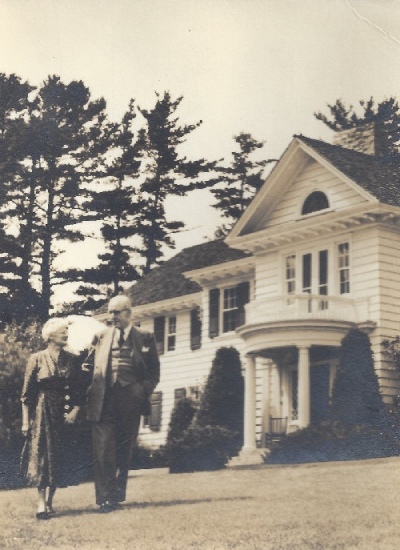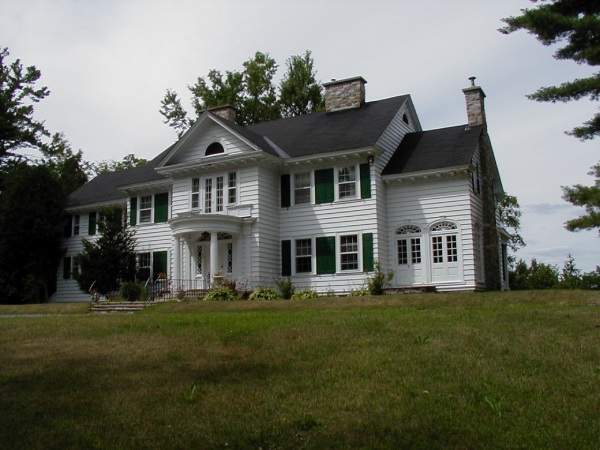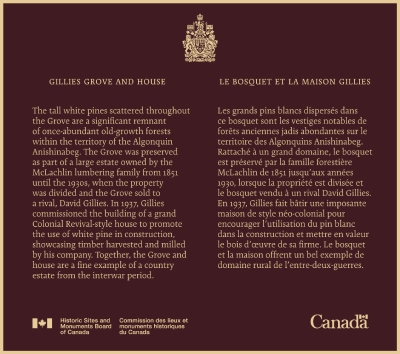Gillies Grove and House National Historic Site

© Courtesy of Iain Buchanan
Gillies Grove and House were designated as a national historic site in 1993.
Commemorative plaque: 412 Gillies Grove, Arnprior, OntarioFootnote 1
The tall white pines scattered throughout the Grove are a significant remnant of once-abundant old-growth forests within the territory of the Algonquin Anishinabeg. The Grove was preserved as part of a large estate owned by the McLachlin lumbering family from 1851 until the 1930s, when the property was divided and the Grove sold to a rival, David Gillies. In 1937, Gillies commissioned the building of a grand Colonial Revival-style house to promote the use of white pine in construction, showcasing timber harvested and milled by his company. Together, the Grove and house are a fine example of a country estate from the interwar period.
Gillies Grove and House
Located within the traditional territory of the Algonquin Anishinabeg, Gilles Grove, with its scattered white pines, is evidence of the once-abundant old-growth forests in the Ottawa region.
In 1851, Daniel McLachlin, a lumber baron who owned mills in the Ottawa area, acquired the land where the Gillies Grove and House are now located. He decided to preserve a section of the land in the 1870s to protect the site and its trees from the saws of lumberjacks. The Grove was used for family outings, various community sporting events, and church picnics.
After his company went bankrupt, McLachlin’s property was divided in two. His rival, David Gillies, bought part of it in the 1930s to create a private estate and preserve the integrity of the Grove. In 1937, Gilles commissioned the building of a grand Colonial Revival-style house, based on the plans of architect Henry Gordon Hughes. Hughes had already designed several other houses in Ottawa’s Rockcliffe Park neighbourhood.
Gillies chose to do minimal landscaping to maintain the impression of an undisturbed environment. The Gillies House used primarily white pine as a building material to showcase the timber harvested and milled by the Gilles company. Together, the Grove and house are a fine example of a country estate from the interwar period.
Backgrounder's last update: 2022-04-13

© Parks Canada

© Parks Canada
Description of historic place

Gillies Grove and House National Historic Site of Canada is a 20th-century estate, located in a forested area at the edge of the Ottawa River on the outskirts of Arnprior, Ontario. The major elements consist of a stand of old growth forest encircling a cleared area with a handsome, Colonial Revival house constructed from the white pine of the forest itself. The designation refers to the estate with its component parts including the forest grove, the house, the carriage house, the gate house, and landscaped areas.
Heritage value
Gillies Grove and House was designated a national historic site of Canada because: the grove is one of the few remaining accessible woodlots containing significant stands of old growth Ottawa Valley white pine; it has direct associations with two of the Valley’s most prominent forest industry families, the McLachlins and the Gillies; the house is a showcase for the white pine products grown, harvested and milled by the Gillies Brothers; the house is a fine example of a country estate from the interwar period rendered in the Colonial Revival style.
The heritage value of this site resides in the integrity of the estate comprised of a forest grove and clearing with house, subsidiary buildings and landscaped areas. Gillies Grove is one of the few remaining accessible Ottawa Valley woodlots with significant stands of old growth white pine, long the mainstay of the region’s lumber industry. For more than 125 years the grove was owned and conserved by two of the Valley’s great lumbering families, the McLachlins and the Gillies. In 1937, a fine Colonial Revival style house was built in a clearing in the grove to showcase the white pine products grown, harvested and milled by Gillies Brothers. The grove and house together form a well-preserved example of a country estate from the interwar period.
Source: Historic Sites and Monuments Board of Canada, Minutes, June 1994.
The National Program of Historical Commemoration relies on the participation of Canadians in the identification of places, events and persons of national historic significance. Any member of the public can nominate a topic for consideration by the Historic Sites and Monuments Board of Canada.
- Date modified :